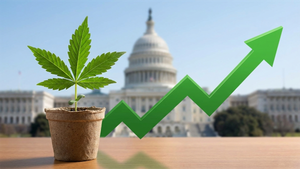
Financial markets are currently gripped by a palpable shift, as recent weakening labor market data and the impending release of crucial inflation reports are coalescing to intensify expectations for Federal Reserve interest rate cuts. This confluence of economic indicators is sending clear signals across the financial landscape, prompting investors, businesses, and consumers alike to brace for significant adjustments in monetary policy. The immediate implications are a surge in market volatility, a rally in bond markets, and a re-evaluation of growth prospects for public companies.
The intensifying drumbeat for rate cuts stems from a clear deterioration in the U.S. labor market. August's non-farm payrolls report delivered a stark message, with a mere 22,000 jobs added, significantly underperforming expectations and marking a sharp decline from the previous month. Compounding this, June's figures were revised downwards to a net loss of 13,000 jobs – the first monthly decline since December 2020. This trend underscores a labor market that was far less robust than previously believed, a fact further solidified by a record downward revision of 911,000 jobs through March 2025. This weakening employment picture, with the unemployment rate rising to 4.3% and wage growth slowing, is now seen as a primary driver compelling the Federal Reserve to consider interest rate reductions, potentially outweighing persistent inflation challenges.
Weakening Labor Market and Stubborn Inflation Set the Stage for Fed Action
The narrative unfolding in the U.S. economy points to a Fed caught between a softening labor market and stubbornly elevated inflation. The August 2025 non-farm payrolls report proved to be a pivotal moment, showing job creation decelerating sharply, falling well short of economists' forecasts. The revisions to prior months' data painted an even bleaker picture, revealing that the labor market had been considerably weaker than initially reported for much of the year. Federal Reserve Chair Jerome Powell has acknowledged the "downside" risks to employment, signaling the central bank's growing concern over job losses and economic contraction.
Adding to the complexity are the upcoming inflation reports, particularly the August Consumer Price Index (CPI), which is forecast to show a headline annual increase of 2.9%. While this would represent the fastest pace since January, it remains above the Fed's 2% target. Core CPI, excluding volatile food and energy prices, is also expected to hold steady at 3.1%, maintaining pressure on the central bank. The persistent presence of tariff-related price pressures continues to modestly raise inflation, creating a dilemma for the Fed: delay cuts and risk further harming the labor market, or ease prematurely and potentially reignite inflationary pressures. Despite inflation hovering above target, the deteriorating employment picture has unequivocally intensified market expectations for rate cuts.
As a direct consequence of these developments, markets are now pricing in a near-certainty of a Federal Reserve rate cut in September by at least 25 basis points (0.25%). Some analysts are even debating the possibility of a larger 50-basis-point cut given the extent of the labor market's weakening. Futures traders are anticipating a total of three 0.25-percentage-point cuts by the December meeting. This anticipation has already sparked a rally in the bond market, with Treasury yields plunging to their lowest levels since early April, and the U.S. Dollar (USD) depreciating against other major currencies. Stock market reactions have been more mixed, initially surging on the "bad news is good news" sentiment, only to close lower as underlying concerns about economic weakness tempered optimism. This volatility is expected to continue as investors weigh the benefits of cheaper capital against fears of an impending economic slowdown.
Key players involved include the Federal Reserve's Federal Open Market Committee (FOMC), which will make the ultimate decision on interest rates, as well as various government agencies (like the Bureau of Labor Statistics) that provide the economic data shaping these decisions. Economists across Wall Street are intensely scrutinizing every data point, revising their forecasts, and influencing market sentiment. Initial market reactions have seen interest-rate sensitive sectors, particularly technology and real estate, showing signs of potential buoyancy, while the broader market grapples with the dual signals of an easing Fed and a softening economy.
Rate Cuts: A Double-Edged Sword for Corporate Fortunes
The prospect of Federal Reserve interest rate cuts casts a long shadow over the corporate landscape, promising a mixed bag of fortunes for public companies and entire sectors. While lower borrowing costs are generally seen as a stimulant for economic activity, the specific context of these cuts—driven by a weakening labor market—introduces nuances that will define who thrives and who struggles.
The Winners' Circle: Sectors and companies that typically thrive in a lower interest rate environment are poised to benefit significantly. The Housing and Construction sector stands to gain immensely, as cheaper mortgage rates make homeownership more accessible and stimulate demand in the housing market. Homebuilders like PulteGroup (NYSE: PHM), D.R. Horton (NYSE: DHI), and Lennar (NYSE: LEN) are likely to see increased sales and project starts. This ripple effect will extend to construction equipment manufacturers such as Caterpillar (NYSE: CAT) and building material suppliers like Builders FirstSource (NYSE: BLDR).
Small-Cap Stocks, represented by indices like the Russell 2000, are also typically beneficiaries. Smaller companies often carry higher variable-rate debt, and reduced interest expenses directly boost their profitability while making capital more accessible for expansion. The Technology Sector, especially growth-oriented companies heavily reliant on external funding for innovation and development, stands to see a boost. Lower discount rates increase the present value of future earnings, improving valuations for firms like those in AI infrastructure and chip development. Companies that have historically leveraged cheap capital for aggressive growth, such as Uber (NYSE: UBER) and Airbnb (NASDAQ: ABNB), could find their growth trajectories re-energized.
Consumer Discretionary companies may also see increased spending as lower interest rates reduce household debt costs and improve consumer purchasing power. This could benefit big-box retailers, apparel brands like Nike (NYSE: NKE), and entertainment giants like Disney (NYSE: DIS). Furthermore, Utilities and Real Estate Investment Trusts (REITs), often viewed as income-generating alternatives to bonds, become more attractive as bond yields fall. Companies like Duke Energy (NYSE: DUK) and Realty Income Corp (NYSE: O) could see increased investor interest. Highly leveraged companies or those with significant floating-rate debt, such as Peloton Interactive (NASDAQ: PTON), Lumen Technologies (NYSE: LUMN), and Petco Health & Wellness (NASDAQ: WOOF), will experience an immediate reduction in interest expenses, directly improving their bottom lines.
The Potential Losers: Conversely, some sectors may face headwinds. Financials, particularly traditional banks, often experience pressure on their net interest margins (NIMs) when rates fall, as the spread between what they earn on loans and pay on deposits narrows. This could impact the profitability of major commercial banks. While investment banks like Goldman Sachs (NYSE: GS) might benefit from increased capital markets activity, the broader banking sector could feel the squeeze.
Companies with significant cash reserves or business models that generate income primarily from interest earned on investments will see a reduction in that income stream. While some technology companies are poised to win, others, particularly those that have seen massive valuation increases based on growth expectations, could experience short-term underperformance if rate cuts signal a broader economic slowdown or trigger an "unwind" of certain overextended trades, potentially impacting giants like Nvidia (NASDAQ: NVDA). While usually a winner, the consumer discretionary sector could also struggle if rate cuts are a signal of severe economic weakness rather than a benign adjustment. The market will be carefully dissecting the Fed's messaging to understand the underlying drivers of any rate decisions.
A Shifting Economic Landscape: Broader Implications and Industry Ripples
The Federal Reserve's anticipated pivot to interest rate cuts, driven by a weakening labor market and persistent inflation, signifies a profound shift in the economic landscape with far-reaching implications across industries, competitive dynamics, and regulatory considerations. This delicate policy maneuver is designed to stimulate economic activity, but its execution walks a tightrope between averting a recession and re-igniting inflationary pressures.
The wider significance of these rate cuts lies in the Fed's primary aim to encourage investment, spending, and hiring by making borrowing cheaper. Recent labor market data, including a significant miss in August's non-farm payrolls and a rise in the unemployment rate to 4.3%, has firmly pushed employment risks to the forefront of the Fed's concerns, even as inflation remains above its 2% target. This move acknowledges that a severe contraction in employment could have more devastating long-term consequences than a slight overshoot on inflation. Interestingly, some economists posit that lower mortgage rates, a direct result of Fed cuts, could paradoxically help cool a significant component of the Consumer Price Index (CPI) by reducing rents, thus aiding overall inflation reduction. However, the risk remains that easing policy while inflation is still elevated and financial conditions are already loose could exacerbate asset price inflation, potentially leading to asset bubbles.
Looking at broader industry trends, the Technology Sector, especially companies focused on high-growth areas like AI infrastructure and chip development, stands to benefit significantly. Lower interest rates reduce their cost of capital for R&D and expansion, and concurrently boost their valuations by decreasing the discount rate applied to future earnings. The Housing and Construction Sector is set for a substantial boost as reduced mortgage rates fuel demand for homeownership, leading to increased activity for homebuilders, contractors, and material suppliers. Manufacturing could also see a resurgence, benefiting from cheaper financing for new equipment and technologies, with a potentially weaker U.S. dollar making exports more competitive.
The ripple effects on competitors and partners will be extensive. Cheaper capital incentivizes increased capital expenditures and M&A activity across the board. Companies with robust balance sheets and existing access to capital could consolidate their market positions, intensify competition, and potentially lead to a surge in deal-making as acquisition financing becomes more attractive. Supply chains will also feel the impact, as stimulated consumer and business demand could lead to higher demand for raw materials and components, requiring suppliers to adapt to increased volumes and potential price fluctuations. While consumers benefit from lower rates on various loans, savers will face reduced returns on their deposits, creating a divergence in financial outcomes.
From a regulatory and policy perspective, the Fed's decision underscores its commitment to the dual mandate, with a clear shift in focus towards employment stability given recent data. This prolonged period of potentially lower rates could raise concerns among policymakers about asset price bubbles, necessitating vigilant risk management from financial institutions. The effectiveness of these rate cuts will also be influenced by other government policies; fiscal stimulus could amplify their effect, while restrictive fiscal measures might temper it. Historically, job markets have generally responded positively to rate cuts, though the immediate impact can be nuanced. Comparisons to the Great Recession of 2008-2009 and the COVID-19 pandemic in 2020 show that while rate cuts are crucial for stabilization and recovery, their success hinges on the broader economic context. The challenge for the Fed now is to engineer a "soft landing," controlling inflation without tipping the economy into a severe recession, a feat that history shows is difficult to achieve.
What Comes Next: Navigating the Uncharted Waters of Monetary Easing
The Federal Reserve's imminent interest rate cuts, prompted by a weakening labor market and persistent inflation, usher in a period of intense scrutiny and strategic adaptation for both the broader economy and individual market participants. The path ahead is fraught with both opportunities and challenges, requiring careful navigation from businesses, investors, and policymakers alike.
In the short-term, financial markets are poised for continued volatility. While initial stock market reactions might be euphoric, driven by the "bad news is good news" sentiment of monetary easing, underlying concerns about economic weakness could temper sustained rallies. Growth stocks, particularly in the technology sector (e.g., those involved in AI infrastructure and chip development), and small-cap companies, being more sensitive to interest rates, could see an immediate boost due to reduced borrowing costs. However, some analysts warn of a potential "sell-the-news" event as investors recalibrate their positions against broader macroeconomic data. The bond market, conversely, is expected to see Treasury yields decline, particularly on the short end, leading to a rally in existing bond prices. The U.S. dollar is likely to weaken, potentially benefiting emerging markets, while commodities like gold are expected to perform well in this lower-rate, weaker-dollar environment. Consumers will likely find loan products more affordable, stimulating spending, but savers will contend with reduced returns on deposits. For businesses, cheaper borrowing costs will encourage capital expenditures and potentially a surge in mergers and acquisitions.
The long-term outlook is more intricate, contingent on the Fed's ability to stimulate growth without reigniting inflation. A "soft landing," where the Fed successfully engineers growth and job creation without triggering a significant inflationary spiral or a severe recession, remains the most optimistic scenario. This could lead to sustained economic growth, stable employment, and a positive, albeit potentially volatile, stock market performance over the coming years. However, a key long-term risk of sustained low rates is the potential for increased money supply to fuel inflationary pressures, eroding corporate profit margins and consumer purchasing power. There's also the possibility of a "hard landing" or a full-blown recession if the rate cuts are a reaction to a rapidly weakening economy, leading to continued market struggles and job losses.
Strategic pivots will be paramount for businesses. Companies will likely seize opportunities to refinance existing debt at lower rates, improving profit margins and cash flow. Capital-intensive businesses may find it more attractive to undertake new investments and expansion projects. If economic weakness deepens, a renewed focus on cost efficiencies and strengthening balance sheets will become critical. For investors, portfolio rebalancing is crucial. This might involve increasing exposure to U.S. large-cap and AI-driven sectors while hedging against global volatility. Cyclical sectors like small-cap stocks, autos, airlines, and homebuilders are poised to benefit, while defensive sectors such as utilities, consumer staples, and healthcare may offer stability in a slower-growth environment. Allocations to high-quality corporate bonds and alternative assets like gold and cryptocurrencies could also be considered for diversification and protection against inflation. However, investors must remain cautious, as persistent inflation risks or a hawkish surprise from the Fed could quickly disrupt market optimism. Policymakers, including the Fed, will continue their data-dependent approach, balancing employment and inflation risks, with potential fiscal stimulus measures possibly amplifying the effects of monetary easing.
The overarching challenge is for the Federal Reserve to strike the right balance, steering the economy through a period of decelerating growth and persistent inflation towards a more stable future. The market will be closely watching for further labor market data, inflation reports, and, critically, the Fed's communications for clues on the pace and extent of future rate adjustments.
Conclusion: A Balancing Act for Economic Stability
The Federal Reserve's anticipated move to cut interest rates, driven by a confluence of weakening labor market data and ongoing inflation concerns, marks a critical juncture for the U.S. economy. This pivotal policy shift is a proactive measure designed to invigorate economic activity by lowering borrowing costs, thereby encouraging investment, spending, and hiring. The pronounced slowdown in job growth, coupled with a rising unemployment rate, has underscored the Fed's renewed focus on supporting employment amidst signs of economic distress.
Moving forward, the market is poised for continued dynamism and potential volatility. While the immediate allure of cheaper capital may fuel rallies in certain sectors, particularly those sensitive to interest rates like technology, real estate, and small-cap stocks, underlying concerns about the broader economic health that necessitated these cuts will remain. Investors should prepare for a complex environment where the benefits of monetary easing are weighed against the implications of a softening economy. The bond market is likely to see further yield compression, while the U.S. dollar may experience continued depreciation.
The lasting significance of these rate cuts hinges on the Fed's ability to orchestrate a "soft landing"—stimulating growth and job creation without reigniting inflationary pressures. This delicate balancing act aims to foster a sustained economic recovery and stable employment. However, a misstep could lead to either a "hard landing" characterized by recessionary pressures or, conversely, a resurgence of inflation, creating a challenging environment for all stakeholders. The current economic backdrop, featuring a unique blend of cooling labor dynamics, persistent price pressures, and rapid technological advancements, renders this particular rate-cutting cycle uniquely complex.
For investors in the coming months, vigilance is paramount. Close monitoring of key economic indicators will be essential: scrutinize upcoming inflation reports, particularly the personal consumption expenditure (PCE) index, for signs of persistent price pressures; track labor market health through unemployment rates, job growth figures, and wage inflation for insights into economic momentum; and pay meticulous attention to communications from Federal Reserve officials for clues on their outlook and future policy trajectory. Observing the yield curve can also offer valuable insights into market expectations for economic growth and inflation. Strategic portfolio diversification across asset classes, with a potential tilt towards growth-oriented sectors, real estate, and small-caps, while prudently managing exposure to traditional banking stocks, will be crucial. The ultimate success of the Fed's strategy will unfold through diligent monitoring and careful policy adjustments, as the economy navigates these uncharted waters.





